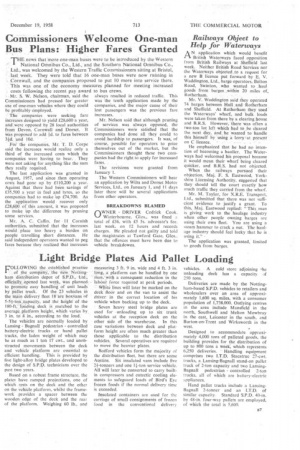Light Bridge Plates
Page 41

If you've noticed an error in this article please click here to report it so we can fix it.
Aid Pallet Loading
FOLLOWING the .esta Wished practice of the comparik,ltbe new Notting ham distribution depot of officially, Opened last week, was planned to Promote easy handling of unit loads by pallet truck. Of the .23 vehicles in the main deliverY fleet 18 ate boxyans of 5 44-tgli,:apackty, and the height of the 180-ft,loading deck is .matched to the average, platform height, which varies by 3 in. td 4 in., aecording to, the load.
The vehicles are normally loaded by Lansing Bagnall pedestrian controlled battery-electric trucks or hand pallet trucks, the laden weight of which may be as much as 1 ton 17 cwt., and unobstructed movements between the deck and vehicle platform are essential to efficient handling. This is provided by five light-alloy bridge plates developed to the design of S.P.D. technicians over the past two years. •'
Based on a robust frame structure, the plates have ramped projections, one of which rests on the deck and the other on the vehicle platform, whilst the framework' provides a spacer between the wooden edge of the deck and the rear of the platform. Weighing 60 lb., and
measuring 3 ft. 9 in. wide and 4 ft. 3 in. long, a platform can be handled by one with a consequent reduction in the tabour force required at peak periods. White lines will later be marked on the deck floor and on the van to assist the driver in the correct location of his vehicle when backing up to the deck.
. Seven heavy steel bridge plates are used for unloading up to six trunk vehicles at the reception deck on the other side of the wareheuse. In this case variations between deck and platform height are often much greater than those applicable to the distribution vehicles. Several operatives are required to move the heavier plates.
Bedford vehicles form the majority of the distribution fleet, but there are some Austins. Six insulated vans include five 21-tanners and one 11-ton service vehicle. All will later be converted to carry builtin compressors and eutectic cooling elements to safeguard loads of Bird's Eye frozen foods if the normal delivery time is exceeded.
Insulated containers are used for the carriage of small consignments of frozen food in the conventional delivery vehicles. A cold store adjoining the unloading deck has a capacity of 250 tons, Deliveries are made by the Nottingham-based S.P.D. vehicles to retailers and wholesalers over an area of approximately 1,600 sq. miles, with a consumer population of 1,738,000. Outlying centres in the area include Mansfield in the north, Southwell and Melton Mowbray in the east, Leicester in the south, and Burton-on-Trent and Wirksworth in the west.
Designed to accommodate approximately 4,000 tons of palleted goods, the building provides for the distribution of up to 800 tons a week, which represents 6,250 deliveries. Handling equipment comprises two I.T.D. Stacatruc 27-cwt. trucks, a Lansing-Bagnall stand-on pallet truck of 2-ton capacity and two LansingBagnall pedestrian controlled 2-ton trucks, all of which are battery-electric appliances.
Hand pallet trucks include a LansingBagnall 2-tonner and an LT.D. of similar capacity. Standard S.P.D. 40-in. by 48-in, four-way pallets are employed, of which the total is 5,600.




































































































